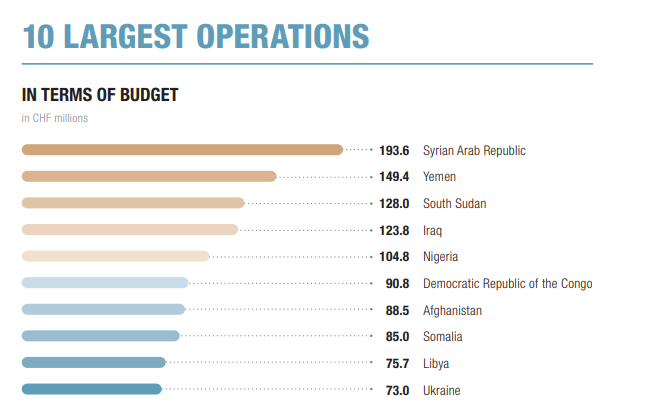1/ According to our legal analysis @ICRC, there are 100+ #armedconflicts around the https://abs.twimg.com/emoji/v2/... draggable="false" alt="🌍" title="Europa-Afrika auf dem Globus" aria-label="Emoji: Europa-Afrika auf dem Globus"> involving 60+ States & 100+ non-state armed groups as parties to those conflicts. A few trends we observe, first-hand:
https://abs.twimg.com/emoji/v2/... draggable="false" alt="🌍" title="Europa-Afrika auf dem Globus" aria-label="Emoji: Europa-Afrika auf dem Globus"> involving 60+ States & 100+ non-state armed groups as parties to those conflicts. A few trends we observe, first-hand:
 https://abs.twimg.com/emoji/v2/... draggable="false" alt="⬇️" title="Pfeil nach unten" aria-label="Emoji: Pfeil nach unten">
https://abs.twimg.com/emoji/v2/... draggable="false" alt="⬇️" title="Pfeil nach unten" aria-label="Emoji: Pfeil nach unten">
#IHL
#IHL
2/ The # of armed conflicts in the  https://abs.twimg.com/emoji/v2/... draggable="false" alt="🌍" title="Europa-Afrika auf dem Globus" aria-label="Emoji: Europa-Afrika auf dem Globus">has been on a constant rise at least since the late 1990s. Over the last 20 years, the # of non-international armed conflicts has more than doubled: from less than 30 to 80+! A few factors contribute:
https://abs.twimg.com/emoji/v2/... draggable="false" alt="🌍" title="Europa-Afrika auf dem Globus" aria-label="Emoji: Europa-Afrika auf dem Globus">has been on a constant rise at least since the late 1990s. Over the last 20 years, the # of non-international armed conflicts has more than doubled: from less than 30 to 80+! A few factors contribute:  https://abs.twimg.com/emoji/v2/... draggable="false" alt="⬇️" title="Pfeil nach unten" aria-label="Emoji: Pfeil nach unten">
https://abs.twimg.com/emoji/v2/... draggable="false" alt="⬇️" title="Pfeil nach unten" aria-label="Emoji: Pfeil nach unten">
3/  https://abs.twimg.com/emoji/v2/... draggable="false" alt="1⃣" title="Tastenkappe Ziffer 1" aria-label="Emoji: Tastenkappe Ziffer 1">Non-state armed groups continue to multiply, as armed groups often split into factions & new armed groups emerge, generating new conflicts.
https://abs.twimg.com/emoji/v2/... draggable="false" alt="1⃣" title="Tastenkappe Ziffer 1" aria-label="Emoji: Tastenkappe Ziffer 1">Non-state armed groups continue to multiply, as armed groups often split into factions & new armed groups emerge, generating new conflicts.
4/  https://abs.twimg.com/emoji/v2/... draggable="false" alt="2⃣" title="Tastenkappe Ziffer 2" aria-label="Emoji: Tastenkappe Ziffer 2">Many States intervene in conflicts abroad, often through partnerships. Many armed conflicts involve “coalitions” (i.e. with at least on one side, two parties or more fighting together) : https://www.icrc.org/en/publication/4498-allies-partners-and-proxies-managing-support-relationships-armed-conflict-reduce">https://www.icrc.org/en/public...
https://abs.twimg.com/emoji/v2/... draggable="false" alt="2⃣" title="Tastenkappe Ziffer 2" aria-label="Emoji: Tastenkappe Ziffer 2">Many States intervene in conflicts abroad, often through partnerships. Many armed conflicts involve “coalitions” (i.e. with at least on one side, two parties or more fighting together) : https://www.icrc.org/en/publication/4498-allies-partners-and-proxies-managing-support-relationships-armed-conflict-reduce">https://www.icrc.org/en/public...
5/  https://abs.twimg.com/emoji/v2/... draggable="false" alt="3⃣" title="Tastenkappe Ziffer 3" aria-label="Emoji: Tastenkappe Ziffer 3">The increase in the # of armed conflicts is mainly happening in countries already affected by other armed conflicts, feeding each other. These protracted conflict situations may last for decades.
https://abs.twimg.com/emoji/v2/... draggable="false" alt="3⃣" title="Tastenkappe Ziffer 3" aria-label="Emoji: Tastenkappe Ziffer 3">The increase in the # of armed conflicts is mainly happening in countries already affected by other armed conflicts, feeding each other. These protracted conflict situations may last for decades.
6/ Top @ICRC humanitarian operations take place in countries affected by armed conflict – sometimes multiple armed conflicts, and often protracted over decades.
7/ @ICRC classifies conflicts based on legal criteria & facts on the ground. + https://abs.twimg.com/emoji/v2/... draggable="false" alt="📕" title="Geschlossenes Buch" aria-label="Emoji: Geschlossenes Buch">on these criteria: Commentary to Common Article 2 (for international armed conflicts) & Common Article 3 (for non-international armed conflicts) of the #GenevaConventions:
https://abs.twimg.com/emoji/v2/... draggable="false" alt="📕" title="Geschlossenes Buch" aria-label="Emoji: Geschlossenes Buch">on these criteria: Commentary to Common Article 2 (for international armed conflicts) & Common Article 3 (for non-international armed conflicts) of the #GenevaConventions:
https://ihl-databases.icrc.org/applic/ihl/ihl.nsf/Treaty.xsp?documentId=77CB9983BE01D004C12563CD002D6B3E&action=openDocument">https://ihl-databases.icrc.org/applic/ih...
https://ihl-databases.icrc.org/applic/ihl/ihl.nsf/Treaty.xsp?documentId=77CB9983BE01D004C12563CD002D6B3E&action=openDocument">https://ihl-databases.icrc.org/applic/ih...
8/ Now, a short video to recap:

 Read on Twitter
Read on Twitter


